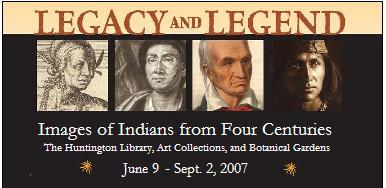"Legacy and Legend: Images of Indians from Four Centuries""For centuries European-trained artists created art for audiences that knew little about Indians, and so their images often romanticized them and focused on the more dramatic," says guest curator Kathryn Hight. As artists capitalized on new printing technologies and a growing demand for prints and illustrated books, they worked to make their pieces marketable by depicting the more colorful aspects of Indian culture: unusual clothing and adornment, ritual ceremonies, and dangerous activities such as buffalo hunting. "This selective view created a skewed interpretation of Indian life that has shaped the public's understanding of Native American culture," Hight says. "As artists and craftsmen struggled to interpret what they had seen and learned into forms acceptable to non-Indian markets, they grafted the new images onto the traditions with which they and their audiences were familiar. Their interpretations inevitably distorted perceptions of Indian life, resulting in early forms of docudrama. An American visual epic was being made."
In the 19th century, artists like Catlin and Edward Curtis saw their work as preserving cultures in decline. "Their work often shows Indians dressed from past eras in settings created by the artist's imagination," says Hight. While artists depicted Indian life as immutable, by the early part of the 20th century Indian life had changed markedly, adapting in the wake of European settlement. "It was a much more complicated picture than many artists were willing to portray," says Hight. "While the show does depict a great variety of Indian images, the fact is only a few transcended time, and those are what dominate our consciousness even today."Comment: Once again, an expert has spoken. Media images "created a skewed interpretation of Indian life" and "dominate our consciousness even today." Anyone who has studied the issue knows this to be true.



1 comment:
ES Curtis's romanticizing of Indians in Americas west is certainly a topic of debate. I can't really say if he was a maker/changer of history, or just an artist. Perhaps it was all of these.
Further on this topic is a film that shows what might constitute his romanticizing; The Indian Picture Opera... it is a recreation of a 1911 Curtis lecture and slide show of his images. In it, you can hear what he was saying at the time (1911). It can be searched on Amazon (dvd). It is absorbed in his words, not just 100 years of pictorial analysis by others. I dare say few have read any of the text in the North American Indian editions, since only a few hundred copies were sold. Most of those reside in private collections, or have been torn apart and sold page by page, (the photos, that is). The text has been discarded and largely ignored.
For those who have never read a page from The North American Indian, well this is an opportunity.
It reflects on the intent of him as an individual, and puts his actions into clearer focus.
Post a Comment